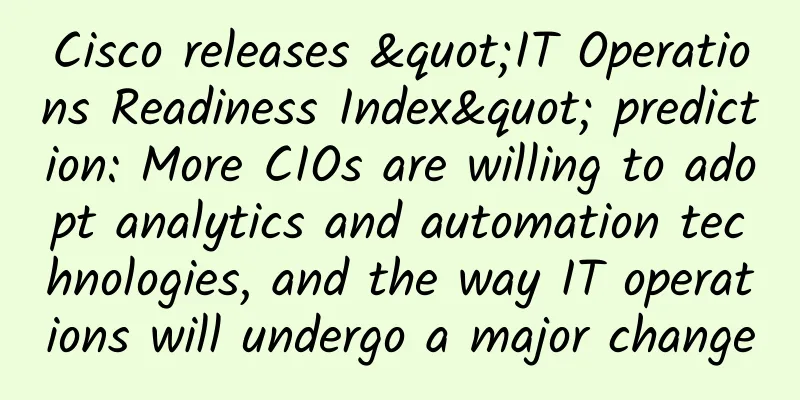Cisco releases "IT Operations Readiness Index" prediction: More CIOs are willing to adopt analytics and automation technologies, and the way IT operations will undergo a major change

|
Recently, Cisco announced the launch of a new IT Operations Readiness Index, which aims to reveal how data is transforming the way enterprises operate IT. The index report is based on a survey of more than 1,500 senior IT leaders around the world. The purpose is to understand the stage of organizations in the IT operations transformation process, revealing a four-stage model of IT operations readiness, focusing on how organizations deal with the events they face. “As infrastructure complexity continues to grow, IT leaders can no longer rely on monthly reports and heavy manual operational tasks to deliver results as they did in the past,” said Joseph Bradley, global vice president of Cisco’s Internet of Things, Blockchain Technology, Artificial Intelligence and Business Incubation business. “Driven by data and supported by automation technology, IT can achieve real-time operations, gain predictive capabilities, and truly play its role based on detailed data to create strategic value for the organization and customers.” Brief Introduction to IT Operations Readiness Index Research Today, IT departments spend approximately 78% of their budgets on “keeping the lights on,” leaving little for innovation. However, some organizations are reallocating budgets to prioritize transformational projects and move to higher levels in the IT operations maturity model. First, IT must understand where the organization is in the four-stage IT operations maturity model and where it wants to be in two years: More mature organizations say they collect data from more areas of their infrastructure, apply more analytics, and use automation more extensively. To achieve "forward-looking" capabilities, organizations must become more data-driven, using data indicators to predict events (such as network outages) and automation to enable continuous changes and maintain optimal operations. “As organizations move to higher levels in this model, they use data to predict the future,” notes Joseph Bradley. “Through analytics and automation, CIOs can continuously monitor and optimize their infrastructure based on predictions of future needs, rather than reacting to events, such as a network outage. As a result, they can deliver strategic outcomes to business partners, moving from panic to control.” Key findings from the IT Operations Readiness Index study: Operations have become a strategic focus for business success
Investment in operations delivers customer benefits and value to the business
The journey to a “forward-looking” model has just begun
Artificial Intelligence (AI) + Talent = Success
External suppliers are important data sources
Security is the most data-driven area of infrastructure
IoT is the interconnection from IT to the business edge
When IT operations have the right data, the ability to extract the right insights from that data, and the ability to automate operational tasks in their infrastructure, they have the opportunity to gain a competitive advantage. Today, CIOs must focus on innovation in the IT operations space. As Zeus Kerravala of ZK Research puts it, “In the future, the most successful companies will have: the highest quality data, AI algorithms to interpret that data, and a Chief Data Officer (CDO) who can ensure quality and consistency.” |
<<: How to truly experience 1G internet speed in the 5G era? WiFi has become an important help!
Recommend
What process resources are shared between threads?
[[357394]] Processes and threads are two topics t...
BandwagonHost: $99/year - 2GB/40GB/1TB/17 data centers in Hong Kong & Japan, 1-2.5Gbps bandwidth CN2 GIA line
BandwagonHost has launched a special package, a d...
No one is forcing us to upgrade to 5G? The latest regulations are released: those who force 5G packages will be severely punished
I guess everyone here is already familiar with th...
DogYun's new Hong Kong MG VPS starts at 70 yuan per year, 1GB memory/20G SSD/1TB monthly traffic
DogYun (狗云) Classic Cloud Server has a new Hong K...
How to fight the emergency communication battle in the “golden 72 hours”?
Life is the most important thing, and unity is st...
China Mobile: Ready for 5G commercial use, new packages to be released in October
At the China Mobile 5G+ Innovation and Cooperatio...
HostYun: Japan Tokyo Softbank 300M-1Gbps large bandwidth VPS monthly payment starting from 25 yuan
Last year, we shared the information of HostYun&#...
SpeedyPage: $5.39/month KVM-AMD Ryzen, 2G memory, 30G NVMe, 5TB/month, Singapore data center
SpeedyPage is a foreign hosting company establish...
RackNerd Cyber Monday special VPS starts at $8.49 per year, multiple data centers available
Black Friday is followed by Cyber Monday, and t...
Cure the difficulty of choosing! What are the differences between 5G, Wi-Fi 6, and Wi-Fi 6E?
[[428494]] This article is reprinted from the WeC...
Game changers for the branch office: Wi-Fi 6, 4G, 5G and SD-WAN
Today, the use of cloud computing services contin...
How to quickly develop killer applications? Which will have a greater impact on the market, 5G or edge computing?
[[269430]] Is edge computing the first new trend ...
What is missing from the 5G development of radio and television? The fourth largest operator faces four challenges
At the beginning of 2020, there are constant news...
Ministry of Industry and Information Technology: By the end of 2021, more than 600,000 new 5G base stations will be built and more than 20 gigabit cities will be built
[[390193]] On March 24, the Ministry of Industry ...
Design and analysis of weak current intelligent system in intelligent building
The intelligentization of weak-current electricit...









